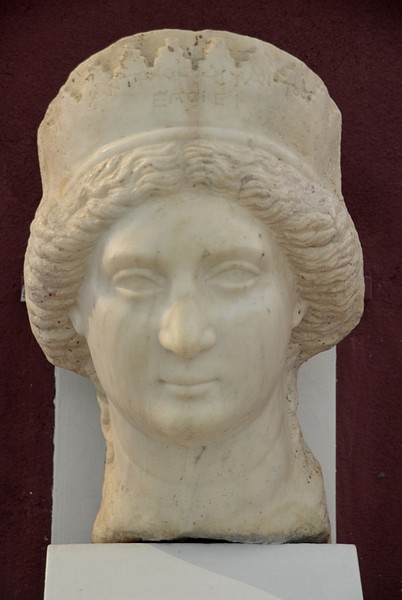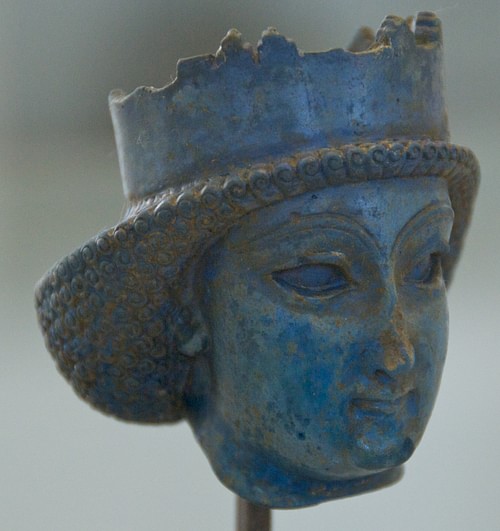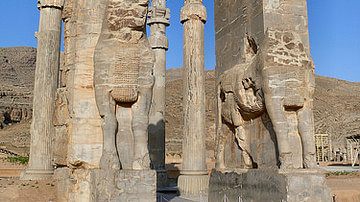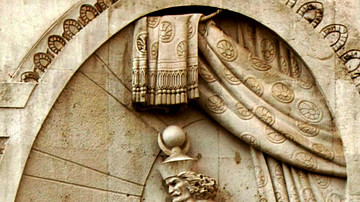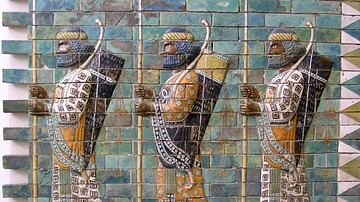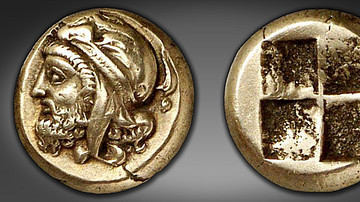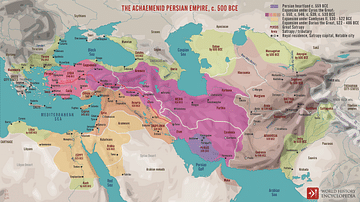Women in ancient Persia had more rights and greater freedom than any other ancient civilization including, according to some scholars, even ancient Egypt which is famous for its respect for the feminine principle in religion as well as daily life.
Persian history was an oral tradition, however, until the Sassanian Empire (224-651 CE) and so most of what is known of ancient Persian culture comes from the Greeks whose historians usually present the Persians unfavorably. Herodotus routinely depicts the Persians as luxurious and their women as manipulative schemers who seemed to have an unnatural control over their men.
In reality, Persian women were no less “scheming” than women of any other culture are depicted by male historians. Persian women had almost equal rights with men and, in many instances, more freedoms and benefits. Many Persian women exercised almost – or total – autonomy and ran their own businesses, supervised male subordinates in the workplace, and served as commanding officers in the military.
The Women & Sources
There are, in fact, so many impressive ancient Persian women that a list of the twelve greatest is difficult to compile. The following represent the best aspects of the many who are not included. These are:
- Cassandane Shahbanu
- Atusa Shahbanu (also given as Atossa)
- Artunis
- Irdabama
- Artemisia I of Caria
- Youtab Aryobarzan
- Musa (also given as Thermusa)
- Sura
- Azadokht Shahbanu
- Purandokht (also given as Boran)
- Apranik
- Banu, wife of Babak
The stories of these women's accomplishments come from a number of sources: Persian oral tradition which was committed to writing during the Sassanian Period and afterwards, the Greek and Roman historians, and administrative/financial documents, preserved in baked clay tablets, found in the ruins of the Achaemenid Persian capital of Persepolis known as the Fortification Tablets, Treasury Texts, and Travel Texts.
The Greeks and Romans frequently depict Persian men as dominated by their women in an effort to make the Persians appear weak and “unmanly” as compared with themselves but, even so, their narratives do often provide insight into and corroboration of historical events and highlight the status of women in Persia.
The following were queens, commanding officers, businesswomen, and guerilla fighters who made a mark on history but there were many other women whose names have been lost who were also well-respected. Women held positions as managers and supervisors, merchants, soldiers, court clerks, priestesses as well as working as laborers, artisans, and entertainers. The women whose names are remembered here are only a small fraction of the number who contributed to the daily life and legacy of the empires of Persia.
Cassandane Shahbanu (l. c. 575-519 BCE)
Cassandane was the wife of Cyrus the Great (r. c. 550-530 BCE), founder of the Achaemenid Empire (c. 550-330 BCE). Shahbanu was a title meaning “King's Lady” and was held by a monarch's principal wife (mother of his heir). Details on Cassandane's life are vague and she is best known as the mother of the second Achaemenid king Cambyses II (r. 530-522 BCE) and his sister (and later wife) Atusa. When she died, according to Herodotus, Cyrus was grief-stricken and decreed an empire-wide period of mourning lasting six days (II.1). As far as the evidence suggests, the various nations of the empire complied easily with this decree suggesting the respect they had for the late queen and her husband. Cassandane, like her husband, is thought to have set the standard of how Persian queens were to be respected. This high regard is evident in the depictions of later queens and, probably most famously, in the example of Queen Esther in the biblical narrative that bears her name. In the biblical account, Esther – though not of Persian birth – commands enough respect from her husband the king that she is not only able to save the Jews of Persia from genocide but turns the tables on their enemies so that they are, instead, eliminated by royal decree.
Atusa Shahbanu (l. c. 550-475 BCE)
The daughter of Cyrus the Great, wife of Cambyses II, Bardia (also known as Smerdis, r. 522 BCE), and Darius I (the Great, r. 522-486 BCE). Atusa is better known as Atossa, the name she appears under in Herodotus, and was considered a great prize as a wife since she was the daughter of Cyrus and Cassandane. Herodotus (in Book III.133) relates the story of Atossa finding a painful growth on her breast and enlisting the aid of the Greek physician (and slave to Darius I) Democedes to cure her (the first recorded case of mastitis in history). This part of Herodotus' narrative is accepted by scholars without challenge but it continues with a tale universally rejected as anything close to truth: the story of how Democedes only cured Atossa on the condition that she talk Darius I into sending him as an advance scout back to his homeland in preparation for Darius I's invasion in 490 BCE and Atossa suggesting the invasion in the first place in order to bring back more Greek slaves of the quality of Democedes. Democedes is sent to scout, cleverly tricks his Persian guards, and escapes (III.134-137). This is one of the most often-repeated stories concerning Queen Atossa in western sources but, in the Persian tradition, this tale is dismissed, and she is known as a strong, independent woman, wife of three kings and mother of Xerxes I, who operated her own business and maintained her own court and military.
Artunis (l. c. 540-500 BCE)
A Lieutenant Commander of the army under Cyrus the Great. Artunis is said to have been the daughter of one of Cyrus' generals, Artebaz, but may have also (or only) served during the reign of Darius I. Nothing is known of her life or service record outside of her name, but she has come to be representative of the many women now understood to have served in the Persian military. Scholar Kaveh Farrokh notes examples of grave goods from excavated tombs which provide ample evidence of women warriors in the Persian army including one woman's tomb from the Achaemenid Period containing a javelin, spear, bow and arrows, and a knife which were clearly her own (128). Persian tradition also cites another famous woman, Pantea Arteshbod, who served as a military commander under Cyrus the Great and played a pivotal role in the Battle of Opis in 539 BCE (later assisting her husband in the formation of the 10,000 Persian Immortals), but there is as little information on her as there is on Artunis. Even so, these women's names represent the many other anonymous female warriors who held high rank in the military.
Irdabama (l. c. 522-486 BCE, reign of Darius I)
The best-known and wealthiest businesswoman attested to in the records of the Achaemenid Empire at Persepolis. Irdabama dealt primarily in wine and grain and oversaw business holdings, production centers, and estates in Iran, Syria, Egypt, Media, and Babylonia. She commanded a workforce of 480 laborers and personally oversaw production, sales, and distribution. Traveling extensively with a large entourage, Irdabama would have been an impressive figure as she arrived at her various estates to conduct her business. She had her own seal in authenticating written documents – further attesting to her high social status – and employed male and female subordinates to oversee business matters, collect revenue, and relay messages.
Artemisia I of Caria (l. c. 480 BCE)
The best-known woman warrior of the Achaemenid period, an admiral in Xerxes I's navy, Artemisia I is famous for her valor at the Battle of Salamis toward the end of Xerxes I's invasion of Greece in 480 BCE. According to Herodotus, Artemisia I was the only member of Xerxes I's war council to advise against engaging the Greeks in a sea battle at Salamis. She suggested he hold back and starve the enemy into submission through blockade (VIII.68). Xerxes I is said to have appreciated her advice but proceeded with the battle anyway during which, even though she had advised against it, Artemisia I fought skillfully. Xerxes I's navy was defeated at Salamis, signaling the beginning of his wider defeat and the failure of the invasion, and so he would have done well to have listened to Artemisia I. After the battle, Xerxes I entrusted her with the safe return of his illegitimate sons to Persia and she vanishes from history afterwards. She had become regent of Caria for her young son Pisindelis after her husband's death, sometime before Salamis, and so most likely returned there and continued her reign until her death.
Youtab Aryobarzan (d. 330 BCE)
Youtab was the sister of the hero Ariobarzanes (l. 386-330 BCE) and fell with him defending the Persian Gates against the invading force of Alexander the Great. After the fall of Susa, Alexander marched toward Persepolis. The Persian king Darius III (r. 336-330 BCE) was trying to gather a new army at Ecbatana to oppose Alexander but needed more time. He sent the satrap Ariobarzanes to hold the Persian Gates, the narrow pass leading through the mountains to the plains of Persis, against the enemy. Youtab fought alongside her brother and, according to how one interprets the ancient accounts, either died in battle with him at the pass or retreated with him to Persepolis where they made a last stand outside the city's walls. Ariobarzanes and Youtab held the pass for a month before they were outflanked, defeated, and killed. Their holding action gave Darius III the time he needed to raise an army even though this force was also defeated by Alexander.
Musa (r. 2 BCE - 2 CE)
Musa (also given as Thermusa) was a Parthian Queen and co-ruler with her son Phraates V (r. 2 BCE-2 CE). She came to the court of the Parthian Empire (247 BCE-224 CE) when she was presented as a concubine by the Roman emperor Augustus (r. 27 BCE-14 CE) to Phraates IV (r. 37-2 BCE) as part of the Armenian treaty of 20 BCE. Musa used her charms and various talents to elevate herself in Phraates IV's favor, eventually becoming his principal wife. Sometime later, she had him poisoned and, after his death, took the throne, co-ruling with Phraates V. They were both assassinated by Parthian nobility in 2 CE, but Musa is remembered as an energetic, ambitious, and ultimately successful woman – even though her reign was short-lived – who was able to cast off her role as one of the king's many concubines to become queen.
Sura (d. c. 224 CE)
A Parthian Princess and military leader, daughter of the last Parthian monarch, Artabanus V (r. 213-224 CE). Sura is thought to have served in the army and possibly been an advisor to her father throughout his reign. This is unclear, however, as there is no record of her earlier service and she only enters history after Ardashir I (r. 224-240 CE), formerly a general in the Parthian army, revolted against Artabanus V and overthrew the Parthians, founding the Sassanian Empire. Artabanus V was killed in battle in 224 CE and Sura then carried on the fight through guerilla tactics, seeking revenge for her father, until she also died in battle.
Azadokht Shahbanu (c. 240-270 CE, reign of Shapur I)
The principal wife of Sassanian monarch Shapur I, Azadokht is thought to have inspired and encouraged the founding of the famous intellectual and medical center of Gundeshapur, a teaching hospital, library, and the greatest institution of higher learning of its time. The founding of Gundeshapur has long been established as occurring under Shapur I's direction but modern-day scholars point to evidence that it was Azadokht who first brought Greek physicians to the court for the purpose of establishing what would become the paradigm for the modern hospital and medical center as well as establishing standards for academic pursuits. Azadokht is also said to have been a skillful swordswoman, diplomat, and – like many royal women – may have operated her own business.
Purandokht (r. 629-631 CE)
Known also as Boran and Buran, Purandokht was the daughter of Kosrau II (r. 590-628 CE) who took the throne in 629/630 CE becoming the first Empress of the Sassanian Empire. She was deposed briefly by her sister Azarmidokht (r. 630 CE) but regained the throne following Azarmidokht's assassination. Purandokht stabilized the empire at a time when it had been weakening steadily through internal strife and external threats in the form of the Arab-Muslim raiders and armies. She established sound diplomatic relations with the Byzantine Empire, improved the economy and infrastructure, and attempted to return the empire to its former glory under earlier kings. She was assassinated by a rival political faction who eventually replaced her with the king Yazdegerd III.
Apranik (d. c. 651 CE)
Apranik was the commander of the Sassanian army against the invading Arab-Muslim forces during the reign of Yazdegerd III (632-651 CE). The Arab Muslims had been making steady encroachments into Persia throughout the 7th century CE and, unlike other threats to the empire, employed innovative tactics like hit-and-run raids, the widespread use of camel-mounted cavalry (which did better on loose, sandy terrain), and were also able to field a much larger army than the Sassanians. Apranik commanded the last Sassanian forces to meet the Arabs in battle and was finally defeated. Afterwards, she continued the struggle, fighting a guerilla war until she was killed in battle.
Banu, Wife of Babak (d. c. 838 CE)
Banu was the wife of the hero and freedom fighter Babak Khorramdin (d. 838 CE) who fought against the occupying forces of the Abbasid Caliphate. By the time Banu and her husband were active, the Arab Muslims had been in control of Persia for almost 200 years and yet Persian resistance to outside domination had not ceased. Banu and Babak led a resistance cell, striking at the Abbasids and then vanishing away, and were consistently successful. They were finally only captured by Abbasid authorities when they were betrayed by one of their own and, afterwards, executed.
Conclusion
After the fall of the Sassanian Empire in 651 CE, the Arab Muslims suppressed the culture in an effort to supplant it with their own. Ancient Persian religion, customs, and traditions, specifically the observance of Zoroastrianism, were suppressed as were other cultural values, including the equality and autonomy of women. Women now became second-class citizens requiring a male's permission to travel, engage in business, marry, or pursue an education. Resistance to Arab Muslim domination continued until the Persians adopted Islam and, in time, were able to establish their own ruling dynasties but the earlier paradigm of women's equality was never again realized at the same level it had existed during the Sassanian Empire.
Purandokht and Azarmidokht would be the last two Persian queens to hold the title of Shahbanu and Queen of Queens until 1967 CE when Farah Pahlavi, wife of the last Shah of Iran Mohammad Reza Pahlavi, revived it. The title has been discontinued since the Islamic Revolution of 1979 CE. Women in Iran today continue to express resistance to the strictures of the regime in various ways available to them, drawing inspiration from the earlier examples of heroic Persian women who refused to surrender the right to direct their own lives.
